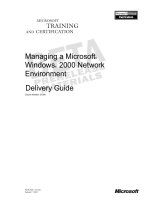Tài liệu Cisco and Microsoft Collaboration in Unified Communications doc
Bạn đang xem bản rút gọn của tài liệu. Xem và tải ngay bản đầy đủ của tài liệu tại đây (1.03 MB, 13 trang )
Cisco and Microsoft
Collaboration in
Unified
Communications
1-800-COURSES
www.globalknowledge.com
Expert Reference Series of White Papers
Written and Provided by
White Paper
All contents are Copyright © 1992–2007 Cisco Systems, Inc. All rights reserved. This document is Cisco Public Information. Page 1 of 11
Cisco and Microsoft Collaboration in Unified
Communications
Cisco
®
and Microsoft have an established track record of collaborating on their respective
products and technologies to provide customers with innovative business solutions.
Today, the two companies are working together to help customers design unified
communications solutions that closely align with their productivity, communications, and
collaboration objectives.
The Cisco approach to unified communications is founded on the company’s market leadership in
secure IP networking and IP communications, and the Microsoft approach is based on its
leadership in desktop applications and operating systems. Even though Cisco and Microsoft have
distinct approaches to unified communications, these approaches are complementary, and
although there are areas of product overlap, both companies are committed to working together to
achieve the same goal: to make communications more efficient and effective for customers. To
help achieve this goal, Cisco and Microsoft actively participate together in open-standards working
groups, including the IETF, and their developers meet regularly on current integration efforts and to
define future areas of integration.
“The interoperability of Live Communications Server
and Office Communicator with Cisco’s communication
offerings will lead to more effective real-time
collaboration capabilities for our mutual customers.”
—Zig Serafin, general manager of the Unified Communications Group at Microsoft
“Cisco and Microsoft are committed to delivering
seamless, interoperable unified communications
solutions that utilize the flexibility and openness of SIP
and allow joint customers to integrate with their existing
infrastructure investments. Employees can now take
advantage of new productivity applications—such as
viewing phone presence state from any location at home
or in the office—to streamline communications and save
both time and money.”
—Barry O’Sullivan, vice president and general manager of the IP Communications Business Unit at Cisco
White Paper
All contents are Copyright © 1992–2007 Cisco Systems, Inc. All rights reserved. This document is Cisco Public Information. Page 2 of 11
Unified Communications
Unified communications is a comprehensive IP communications system that facilitates more
effective, more secure, and more personal communications. It connects users in the way that is
most suitable for them at a given time. It is flexible enough to allow users to transparently transition
across and between applications as interactions warrant, independent of where they are or what
device they are using. Main components include IP telephony, presence servers, integrated
desktop clients, rich-media conferencing, voice and unified messaging, contact center applications,
and mobility solutions. Table 1 lists Cisco and Microsoft unified communications products.
Table 1. Cisco and Microsoft Unified Communications Products
Unified Communications
Components
Cisco Microsoft
IP telephony Cisco Unified CallManager
Cisco Unified CallManager Express
–
Presence server Cisco Unified Presence Server Microsoft Live Communications Server
Integrated desktop client Cisco Unified Personal Communicator Microsoft Office Communicator
Rich-media conferencing Cisco Unified MeetingPlace
®
Cisco Unified MeetingPlace Express
Microsoft Office Live Meeting
Voice and unified messaging Cisco Unity
®
Cisco Unity Connection
Cisco Unity Express
Microsoft Exchange Server 2007 (unified
messaging only)
Contact center Cisco Unified IP Contact Center (IPCC)
Cisco Unified IP Contact Center Express
–
Mobility Cisco Unified Mobility Manager
Cisco Unified CallConnector Mobility
Microsoft Office Communicator Mobile
Groupware – Microsoft SharePoint
Microsoft Groove
Secure network foundation Cisco Integrated Services Routers
Cisco Catalyst
®
Switches
Cisco Self-Defending Network
–
E-mail and directory services – Microsoft Exchange
Microsoft Active Directory
Current Integrations
Cisco Unified Communications with Microsoft Live Communications Server 2005 and Office
Communicator 2005
The integration between Cisco Unified Communications and Microsoft Live Communications Server
2005 delivers enhanced functions to Microsoft Office Communicator 2005 users and allows
organizations to benefit from features inherent in the Cisco Unified Communications system.
Enhanced Microsoft Office Communicator Features with Cisco Unified Communications
●
The click-to-call option allows users to initiate a phone call from one Cisco Unified IP Phone
to another directly from Microsoft Office Communicator. Therefore, when an instant
messaging session needs to escalate into a voice conversation, a user can simply click the
phone icon and then click Call. This action rings both Cisco Unified IP Phones. This feature
can be initiated from an instant messaging chat session in progress or directly from the
contact list.
White Paper
●
The presence status of Cisco Unified IP Phones, such as “in a call” or “idle,” is visible within
Microsoft Office Communicator. A user can see whether the person that he or she is trying
to reach is on a Cisco Unified IP Phone, helping the user determine the most appropriate
form of contact.
●
Microsoft Office Communicator users can benefit from the enterprise-class conferencing
capabilities of Cisco Unified CallManager.
●
Redirection of calls to mobile phones is available, including the capability to use Microsoft
Office Communicator to accept incoming calls on a Cisco Unified IP Phone.
●
When a call is placed to a Cisco Unified IP Phone, a message will pop-up on the user’s
computer and provides the option to click to answer or click to divert.
●
Phone feature controls from Microsoft Office Communicator include hang-up, hold, and
transfer.
The example in Figure 1 shows how to control incoming calls to a Cisco Unified IP Phone with
Microsoft Office Communicator 2005.
Figure 1. Incoming call phone controls
All contents are Copyright © 1992–2007 Cisco Systems, Inc. All rights reserved. This document is Cisco Public Information. Page 3 of 11
1. Mr. Spock receives an incoming call from
Leonard McCoy on his Cisco Unified IP
Phone. An incoming call notification pop-up
message appears within Microsoft Office
Communicator on Mr. Spock’s computer.
2. Mr. Spock can accept the call by clicking the
message, or he can divert the message to
another number by selecting Forward To and
choosing the number to receive the call.
White Paper
The examples in Figures 2 and 3 show the phone presence status of Cisco Unified IP Phones
within Microsoft Office Communicator 2005.
Figure 2. Phone Status “In a call”
1. Mr. Spock needs to speak to James T. Kirk, but Kirk’s
phone presence status indicates that he is “In a call.” If
he wants, in the meantime, Mr. Spock can send James
T. Kirk an instant message letting him know that he
needs to speak to him.
Figure 3. Phone Status ‘Online”
2. After James T. Kirk hangs up his phone, the phone
presence status changes from “In a call” to “Online.”
Mr. Spock can now place his call to Kirk.
All contents are Copyright © 1992–2007 Cisco Systems, Inc. All rights reserved. This document is Cisco Public Information. Page 4 of 11









